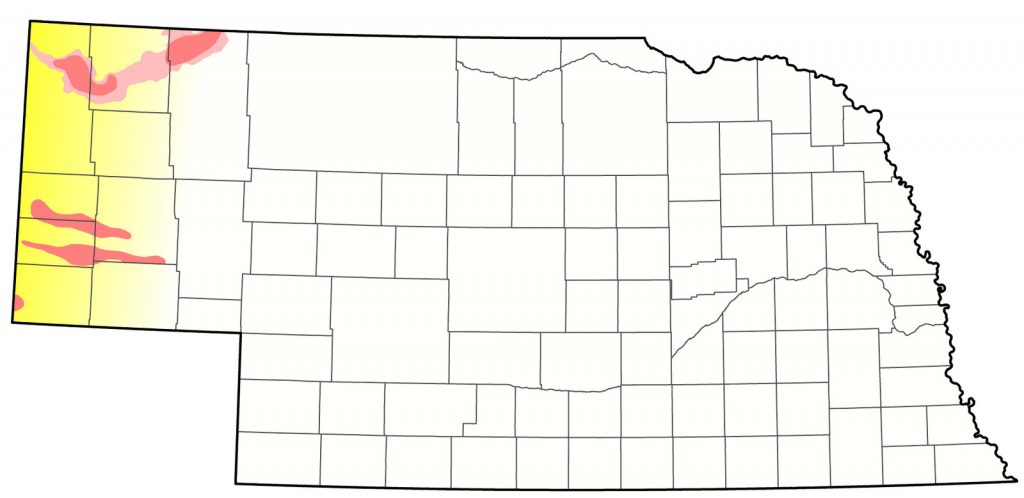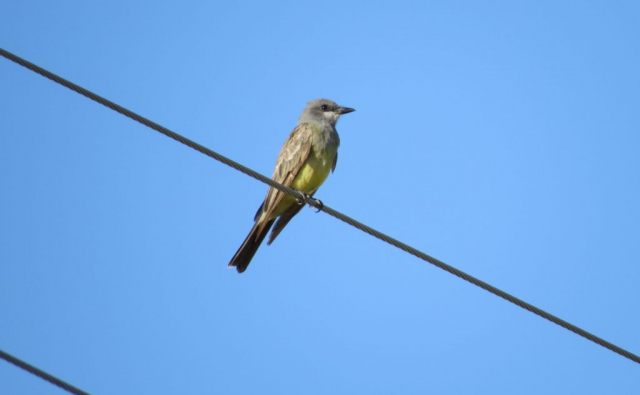Tyrannus vociferans vociferans
Status: Fairly common regular spring and fall migrant west, rare casual central. Fairly common regular breeder west.
Documentation: Specimen: UNSM 6360, 19 Sep 1919 Glen, Sioux Co. This specimen was stated by the collectors to have been taken 9 Sep (Mickel and Dawson 1920).
Taxonomy: Recently, Chesser et al (2018) rearranged the order of subfamilies within the Tyrannidae, placing Tyranninae (Nebraska-occurring genera Myiarchus, Pitangus, Tyrannus) ahead of Fluvicolinae (Nebraska-occurring genera Contopus, Empidonax, Sayornis, Pyrocephalus). We follow this order of genera.
Two subspecies are recognized (AviList 2025), vociferans of the western USA to central Mexico, and xenopterus, of southwest Mexico).
Nebraska birds are vociferans.
Spring: May 8, 8, 8 <<<>>> summer
Earlier dates are 23 Apr 2017 Scotts Bluff Co, 1 May 2021 Pleasant Hill Church, Banner Co, 2 May 1984 (Williams 1985), 2 May 2022 Wright’s Gap Road, Banner Co, and 5 May 2024 (4) Kimball Co.
Last dates of presumed migrants away from known breeding areas are 24 May 2021 near Lewellen, Garden Co, 26 May 2022 Cheyenne Co, 26 May 2025 Lodgepole, Cheyenne Co, 27 May 2019 Ash Hollow SHP, Garden Co, 2 Jun 2011 Oshkosh, Garden Co, and 18 Jun 2010 at Crescent Lake NWR, Garden Co.
There are few spring reports away from known breeding areas, including only five east of the Panhandle: 12 May 1974 Willow Lake, Brown Co (found by Richard Rosche, per James Ducey), and at Ogallala, Keith Co 24 May 2014, 24 May 2019, 28 May 2025 (2), and 21 Jun 2022.
- High counts: 16 on Bighorn Escarpment County Road 14, Banner Co 24 May 2021, 13 at Exit 1 on I-80, Kimball Co 28 May 2024, 7 near Crawford, Dawes Co 18 May 2018, 7 on Buckley Road, Sioux Co 24 May 2021, and 7 at Pine Bluffs, Kimball Co 12 May 2025.
Summer: This species was not recorded by Bruner et al (1904), perhaps overlooked; the first indication of its presence in Nebraska was a report by Mickel and Dawson (1920) that it was “common in northwestern Nebraska in September 1919”. Subsequently a nest with young was found at Chadron SP, Dawes Co 13 Jul 1944 (Gates; Mollhoff 2022), and it was reported in Scotts Bluff Co 27 Apr 1952, but not regularly reported until the 1970s. There are two Keith Co reports: one on 8 May 1953 (Huntley 1953), and another 3 Jul 1996 (Brown and Brown 2001).
Cassin’s Kingbird is most common in the southern Panhandle, especially the Bighorn and Pine Bluffs Escarpments and the Wildcat Hills (Rosche 1982, 1994). It is less common and more localized, but apparently slowly increasing on the Pine Ridge. Generally, it breeds above 3500 feet in elevation; a few high elevation grassland records associated with scattered rocky outcrops (3800-4500 ft) include up to five 1-5 Jun 2016 Agate Fossil Beds, Sioux Co, 21 Jul 2010 near Agate Fossil Beds and two there 23 May 2016, and 12 Jun 2008 Oglala National Grasslands, Sioux Co. At lower elevations, there is some overlap with Western Kingbird, especially where pines and riparian woodland meet.
On the Pine Ridge, breeding season records are surprisingly few, most in the area of Sioux and Dawes Cos between Sowbelly Canyon and West Ash Creek. There is a cluster of records in the area of Metcalf WMA, Sheridan Co that are probably related to the small population in neighboring Bennett, Shannon, and Jackson Cos, South Dakota (Tallman et al 2011). The easternmost Nebraska nesting record is from near Metcalf WMA 4-15 Jun 1986, when a pair was carrying nesting material (Huser 1986). Two were in the same area 12 Jun 1992, one was just north of Metcalf WMA 17 May 2011, and a pair was a few miles further south May 1986. The only record of breeding between West Ash Creek and Metcalf WMA is of two seen 27 Jul 2013 and eight, including a recently fledged juvenile with undeveloped remiges and rectrices, in Deadhorse Canyon, Dawes Co 23 Aug 2014. Two were along 325 Trail, Sheridan Co 20 Jul 2024.
- Breeding Phenology:
Nest Building: 17 Jun
Eggs: 9 Jun-1 Jul
Nestlings: 30 May- 10Jul
Fledglings: 15 Jul-13 Sep - High counts: 19 north of Potter 13 Jun 2009, 18 at Exit 1 on I80, Kimball Co 27 Jul 2024, 16 there 29 Jul 2000, and 14 in canyons south of Redington 2 Jun 2016.
Fall: summer <<<>>> Sep 23, 25, 25
A later date is 4 Oct 2019 (2) Banner Co.
The earliest Nebraska fledgling dates are in mid-Jul (see Breeding Phenology), suggesting that sightings in the last part of Jul are of wandering family groups. Two birds at Wind Springs Ranch, Sioux Co 21 Jul 2001, far from ponderosa pines, and singles in Dundy Co 18 Jul 2020 and at Lake Ogallala, Keith Co 19 Jul 2014 may have been post-breeding wanderers. One along Runner Road, western Cherry Co 5 Jul 2024 may have been a wandering fall disperser.
Rosche (1982) noted that the Cassin’s Kingbird migration peak in fall is rather later than that of Eastern and Western Kingbirds; most “yellow-breasted kingbirds seen after about 10 Sep tend to be Cassin’s” (Rosche 1994). Fitting this pattern are easterly records from Clear Creek WMA, Garden Co 20 Sep 2013, and at or near Lake McConaughy, Keith Co 18 Sep 2024 and 25 Sep 2013. Additional reports east of the Panhandle are 16 Aug 2008 western Cherry Co, 28 Aug 2016 Perkins Co, 6 Sep 2022 Lake Ogallala, Keith Co, 11 Sep 1963 Lincoln Co, 12 Sep 2023 Keith Co, and 17 Sep 2021 Lake Ogallala.
An extraordinary but suggestive report was of one calling and seen well at Valentine, Cherry Co 16 Sep 2021, after Western Kingbirds had departed; unfortunately, the bird was not photographed. Another far easterly report was at Funk WPA, Phelps Co 8 Sep 2023 (Paul Dunbar, personal communication).
- High counts: 114 in Banner Co 24 Aug 2015, 52 in the southern Panhandle 26 Aug 2008, and 44 in Morrill Co 24 Aug 2015.
Images
Abbreviations
NWR: National Wildlife Refuge
SHP: State Historical Park
SP: State Park
UNSM: University of Nebraska State Museum
WMA: Wildlife Management Area (State)
Literature Cited
AviList Core Team, 2025. AviList: The Global Avian Checklist, v2025. https://doi.org/10.2173/avilist.v2025.
Brown, C.R., and M.B. Brown. 2001. Birds of the Cedar Point Biological Station. Occasional Papers of the Cedar Point Biological Station, No. 1.
Bruner, L., R.H. Wolcott, and M.H. Swenk. 1904. A preliminary review of the birds of Nebraska, with synopses. Klopp and Bartlett, Omaha, Nebraska, USA.
Chesser, R.T., K.J. Burns, C. Cicero, J.L. Dunn, A.W Kratter, I.J. Lovette, P.C. Rasmussen, J.V. Remsen, Jr., D.F. Stotz, B.M. Winger, and K. Winker. 2018. Fifty-ninth Supplement to the American Ornithological Society’s Check-list of North American Birds. Auk 135: 798-813. https://doi.org/10.1642/AUK-18-62.1.
Huntley, C.W. 1953. Cassin Kingbird at Brule. NBR 21: 37.
Huser, B.F. 1986. June notes for western Nebraska. NBR 54: 82-83.
Mickel, C.E., and R.W. Dawson. 1920. Some interesting records of Nebraska birds for the year 1919. Wilson Bulletin 32: 73-79.
Mollhoff, W.J. 2022. Nest records of Nebraska birds. Nebraska Ornithologists’ Union Occasional Paper Number 9.
Rosche, R.C. 1982. Birds of northwestern Nebraska and southwestern South Dakota, an annotated checklist. Cottonwood Press, Crawford, Nebraska, USA.
Rosche, R.C. 1994. Birds of the Lake McConaughy area and the North Platte River valley, Nebraska. Published by the author, Chadron, Nebraska, USA.
Tallman, D.A., Swanson, D.L., and J.S. Palmer. 2002. Birds of South Dakota. Midstates/Quality Quick Print, Aberdeen, South Dakota, USA.
Williams, F. 1985. Southern Great Plains Region. American Birds 39: 319-322.
Recommended Citation
Silcock, W.R., and J.G. Jorgensen. 2025. Cassin’s Kingbird (Tyrannus vociferans). In Birds of Nebraska — Online. www.BirdsofNebraska.org
Birds of Nebraska – Online
Updated 17 Jul 2025

